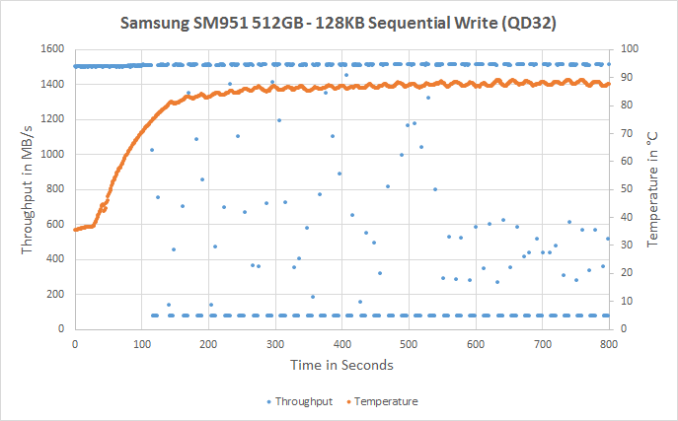Samsung SM951 (512GB) PCIe SSD Review
by Kristian Vättö on February 24, 2015 8:00 AM ESTThermal Throttling
In the previous pages I mentioned I have suspicions that some of the results have been affected by thermal throttling. To confirm my hypothesis, I took my datalogging multimeter and taped its thermal probe on top of the SM951's controller. Then I ran a 128KB sequential write test at queue depth of 32 and plotted the results in the graph below.
Now it's pretty clear why the performance seemed a bit low in the sequential tests. It takes less than two minutes for the drive to begin throttling itself and the performance drops to ~75MB/s. Because the SM951 is an M.2 drive, it doesn't have a chassis or heatsink to help with the heat dissipation, which combined with the fact that the SM951 is more power hungry than most SATA 6Gbps drives results in throttling issues. That said, the drive shouldn't throttle under normal usage because a continuous two-minute transfer isn't very common, but in some more IO intensive workloads with long transfers (e.g. video editing) there's a chance that performance will be affected by thermal issues.
In any case, I strongly recommend having a decent amount of airflow inside the case. My system only has two case fans (one front and one rear) and I run it with the side panels off for faster accessibility, so mine isn't an ideal setup for maximum airflow.
TRIM Validation
The move from Windows 7 to 8.1 introduced some problems with the methodology we have previously used to test TRIM functionality, so I had to come up with a new way to test. I tested a couple of different methods, but ultimately I decided to go with the easiest one that can actually be used by anyone. The software is simply called trimcheck and it was made by a developer that goes by the name CyberShadow in GitHub.
Trimcheck tests TRIM by creating a small, unique file and then deleting it. Next the program will check whether the data is still accessible by reading the raw LBA locations. If the data that is returned by the drive is all zeros, it has received the TRIM command and TRIM is functional.
In the case of the SM951, TRIM appears to be working properly.












128 Comments
View All Comments
blanarahul - Tuesday, February 24, 2015 - link
Can't wait to see what Intel brings to the table considering the amount of focus they put on consistency.extide - Tuesday, February 24, 2015 - link
I'm not sure that we will see anything too interesting client side from them. They seemed to have moved all their focus to the enterprise side, which is of course where the bulk of the money is.FWIW, Intel already has a PCIe SSD that is arguably faster -- the Intel SSD DC P3700
dylan522p - Tuesday, February 24, 2015 - link
Is, not arguablyStuka87 - Wednesday, February 25, 2015 - link
It is faster, and certainly more reliable. Intel has the best enterprise SSDs on the market.FunBunny2 - Wednesday, February 25, 2015 - link
-- Intel has the best enterprise SSDs on the market.Among consumer facing companies, perhaps. The real enterprise SSD/flash players are largely unknown to AnandTech and its readers.
monsted - Wednesday, February 25, 2015 - link
I'd love to see the results of a HDS FMD compared to the usual suspects.Kristian Vättö - Wednesday, February 25, 2015 - link
We've had this conversation before and I'll tell you this again: the majority of flash array vendors are using SSDs from Intel, SanDisk, Samsung and others. There are some that design and build their own drives/blades (e.g. Violin and Skyera), but the vast majority is using third party drives as the heart of their flash arrays.GTVic - Wednesday, February 25, 2015 - link
All drives now should support eDrive.Railgun - Tuesday, February 24, 2015 - link
At the rate I'm going, I'll end up with one of these before my XP941 ever gets powered up once, retail or otherwise.Laststop311 - Tuesday, February 24, 2015 - link
Disappointed in lack of 1TB size/ no 3d vnand/ no nvme. I planned on using 1 of these in 1TB size for a boot drive for a skylake-e build. The good news is I have a couple years for samsung to fix those issues.